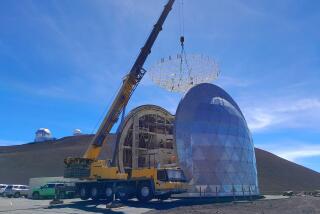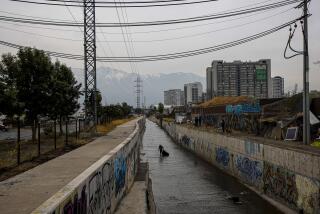Star parties in South America
- Share via
THE astronomer was annoyed.
Luigi “Rolly” Bedin, a young researcher from Padua, Italy, had traveled to northern Chile to study dense groupings of stars called globular clusters. Instead, he’d spent several nights hopelessly waiting for the clouds to clear. Considering northern Chile’s reputation for perpetually perfect astronomical conditions, this was sort of like visiting the Bahamas in the middle of a blizzard.
I could commiserate. When I met Bedin outside a travel agency in June, the same weather had thwarted my amateur stargazing for several frustrating days. Now both of us were going to tour salt flats and sand dunes. We agreed that these were beautiful places — but we’d come to see the stars.
I still had hope, though. My return trip to the Chilean capital of Santiago would take me past Cerro Mamalluca, an amateur observatory built for tourists like me who have come to the area because of its reputation as the emerging astronomy capital of the world. That meant I would have another shot at one of the perfect nights scientists refer to as photometric.
Astronomers have considered northern Chile an ideal laboratory for decades. Its sparse population means there is little light pollution, and the combination of stable air and Andean altitudes produces skies that are largely free of atmospheric distortions. Cerro Tololo Inter-American Observatory, the granddaddy of the region’s world-class observatories, averages more than 300 clear nights a year.
It is not just northern Chile’s atmosphere that makes it the best place to view the heavens this side of the Hubble Space Telescope. Its Southern Hemisphere location also provides excellent views of objects that are difficult or impossible to study from the United States. Among the most interesting of these are the Magellanic Clouds, two small galaxies that orbit our own, as well as the Galactic bulge of the Milky Way, a region that is home to vast clouds of gas, dense groupings of stars and probably a super-massive black hole.
If you have an inner Carl Sagan, northern Chile is the place to be.
The area began sprouting world-class international observatories in the 1960s, when construction began on Cerro Tololo, a U.S.-run observatory in the mountains east of La Serena, a major beach resort.
The Europeans arrived about the same time, forming a group called the European Southern Observatory and building farther to the north, first at a site now known as La Silla. More recently, the organization built Paranal Observatory, a cutting-edge facility on a hilltop hundreds of miles to the north.
Also, the Carnegie Foundation of Washington operates Las Campanas Observatory in the area.
In the last several years, all of these groups have built larger, more powerful telescopes. The biggest of the new telescopes, Paranal Observatory’s creatively named Very Large Telescope, links four mirrors, each about 27 feet in diameter, to create the largest instrument of its kind in the world.
For me, the interesting thing about these telescopes is that most of them collect visible light (as well as invisible infrared rays), harnessing the energy we detect with the naked eye. Whereas much modern astronomy uses receiving dishes and antennas to capture radio waves, microwaves and other things you cannot see, these Chilean instruments are the great-great-grandchildren of Galileo, who didn’t invent the telescope but revealed its power to explore the heavens.
With a little planning, tourists can visit most of these facilities. Many offer free guided tours at least a couple of weekends a month, although visitors must provide their own transportation to the observatories, all of which are intentionally in dark swatches of nowhere.
The stars their destination
FOR my girlfriend, Laura, and me, the solution to this problem was to rent a Toyota and zip toward Cerro Tololo, a facility I’d chosen to visit because of its relative fame and its proximity to La Serena, where we’d rented an inexpensive room. Ominously, though, a low gray fog hung over everything as we drove.“Clear skies, huh?” Laura said doubtfully.
But after passing through a tunnel, we suddenly emerged into what seemed like a different world: The fog had lifted, the sky was bright blue and the green fields around us had turned into scrub brush and cactus. On a distant hilltop, a group of domes glinted in the sunlight. This was Cerro Tololo. We drove up a packed dirt road, winding our way toward what looked like a science-fiction moon base. Huge domed buildings jutted from a 7,200-foot hilltop. To one side, we could see snow-dusted mountains. To the other, a sea of gray clouds broke on the foothills below. The view alone was worth the trip.
Minutes later, Kadur Flores, a 47-year-old amateur astronomer, led us to what we’d really come to see: a telescope swathed in steel beams and black tubes, all pointed at a rectangular opening in the white dome above us.
While we snapped pictures, Flores raised and lowered the floor, spun the telescope and rotated the dome, all with the enthusiasm of a teenager revving the engine on a hotrod. After another guide gave an explanatory talk in Spanish, Flores pulled our group’s three English speakers to the side to make sure we understood everything.
“Optical mirrors are big eyes,” he told us. “The bigger the mirror, the farther away the object we are able to capture.” Although the first optical telescopes — the sort that collect visible light — used glass lenses, using mirrors enables astronomers to build telescopes that are more powerful but less bulky. The instrument beside us had a primary mirror that was 5 feet in diameter — still professional quality but less than a quarter the diameter of cutting-edge models.
Certainly it was dwarfed by the next telescope we saw, a 17-story, 600-ton monstrosity built around a 13-foot mirror. After giving us a few minutes to ogle this colossal instrument, Flores concluded the two-hour tour with a slide show of galaxies, nebulas and supernovas, all of which he narrated as if it were Super Bowl highlights.
An administrative assistant and tour guide, Flores acknowledged he did not understand the Einsteinian math used by Cerro Tololo’s professional scientists. But that had not diminished his love of the stars.
“Astronomy is not only for mathematicians,” he told us wistfully as we left the big telescope. I agreed, but the weather would not acquiesce. For two days after my tour of Cerro Tololo, the night skies were too cloudy for star- gazing, thwarting tourists at Cerro Mamalluca and scientists at professional observatories.
But when I returned a week later — a few days after meeting Bedin — our new guide looked at the night sky, nodded and pronounced it “almost perfect.” Cerro Mamalluca Observatory, a small, circular building that resembles an eerily lighted UFO, sits in the barren hills above the small town of Vicuña, not far from Cerro Tololo.
We arrived at dusk, watched a 45-minute PowerPoint presentation on the Southern skies and returned outside to see the Milky Way streaming brightly across the darkness above us.
Emilio, our guide, shined a green laser pointer into the heavens, pointing out the Southern Cross constellation and the Magellanic Clouds, visible to the naked eye as smears of light across the black sky.
Then he aimed his laser into the constellation Sagittarius, circling the approximate center of the galaxy and a black splotch where cosmic dust blocks the galaxy’s starlight. For ancient Andeans, he told us, this dark area looked like a llama. I saw the similarity too.
Finally, we climbed a spiral ramp into a small dome with a telescope. While piddling compared with the colossal instruments of Cerro Tololo, the telescope’s 12-inch mirror put it at the high end of the amateur range, making it by far the best instrument I’d ever used. And because our group was small, we also had time to observe a slew of celestial objects.
Emilio rotated the dome around us, pointed the telescope through the rectangular opening in its top and began a close-up tour of the universe. We began with Jupiter, a ball of light with four smaller points — the planet’s largest moons — glittering around it like diamonds on black velvet.
Then we studied the triple-star system of Alpha Centauri, the closest star system to the sun. Later, we trained the telescope into the Tarantula Nebula, an immense cloud of gases estimated at more than 1,000 light-years across. Next came another nebula, as well as a tightly packed group of stars called a globular cluster. This, I remembered, was what Bedin had come to study.
In the hour we spent looking at the sky, I thought about Bedin, sitting under a much bigger instrument somewhere, engrossed in calculations, trying to make sense of the far-off points of light above him. This, however, did not strike me as nearly as much fun as my own situation — staring into our galaxy and beyond, thankful that the clouds had finally departed and left northern Chile’s window to the heavens as it usually is: spectacularly clear and wide, wide open.
*
(BEGIN TEXT OF INFOBOX)
A heads-up tour in the mountains of Chile
GETTING THERE:
From LAX to Santiago, Lan Chile and American airlines have direct flights (one stop). Restricted round-trip fares begin at $871.
TELEPHONES:
To call the numbers below from the U.S., dial 011 (the international dialing code), 56 (country code for Chile), 51 (the regional code) and the local number.
WHERE TO STAY:
Francisco de Aguirre Hotel, 210 Cordovez, La Serena; 222-991. This is a nice option, with colonial architecture and a pool. Doubles begin at about $76.
Hotel Costa Real, 170 Avenida Francisco de Aguirre, La Serena; 221-010, fax 221-122, https://www.regiondecoquimbo.cl/costareal . Newish hotel has the comfort and atmosphere of a place geared for business travelers. Doubles start at $69.
Residencial Suiza, 250 Cienfuegos, La Serena; 216-092. Budget-minded accommodations with a nice sitting area and bright, clean rooms that start at $20.
WHERE TO EAT:
El Muelle, 4600 Avenida del Mar, La Serena; 216-993, a pub and restaurant with an atmosphere that combines tiki bar with captain’s quarters. Entrees are $4-$13.
For less expensive but still good food amid La Serena’s bustle, visit the Recova building at Prat and Cienfuegos. There you’ll find several restaurants, including Rincón Marino, a seafood spot with a balcony. Entrees range from $2.50 to $9, but competition means nearly everyone will give you a deal if you bargain.
OBSERVATORIES:
Most observatories have free daytime tours several weekends a month, although some do not offer tours year-round. Try to book several weeks in advance.
Cerro Tololo Inter-American Observatory, about 50 miles east of La Serena; 205-200, https://www.ctio.noao.edu . Two tours usually are offered on Saturdays.
European Southern Observatory, Paranal; 55-435-335, https://www.eso.org . Visits are scheduled the last weekend of each month, except December.
Las Campanas Observatory, La Serena; 207-304, https://www.ociw.edu/lco Limited tours are offered at this facility operated by the Carnegie Institution of Washington. Contact Patricia Villar at the number above or at [email protected].
Cerro Mamalluca, 260 Gabriela Mistral, Vicuña; 411-352, https://www.angelfire.com/wy/obsemamalluca . This facility allows amateurs to gaze at the stars, not just the equipment. Reservations usually can be arranged with a few days’ notice. Tours cost about $6, plus $3 more if you need transportation to the observatory.
TO LEARN MORE:
Chilean Embassy, 1732 Massachusetts Ave. N.W., Washington, D.C. 20036; (202) 785-1746, fax (202) 887-5579, https://www.chile-usa.org .
Chile Tourism Board, (866) YESCHILE (937-2445), https://www.visit-chile.org .
— Ben Brazil
More to Read
Sign up for The Wild
We’ll help you find the best places to hike, bike and run, as well as the perfect silent spots for meditation and yoga.
You may occasionally receive promotional content from the Los Angeles Times.






